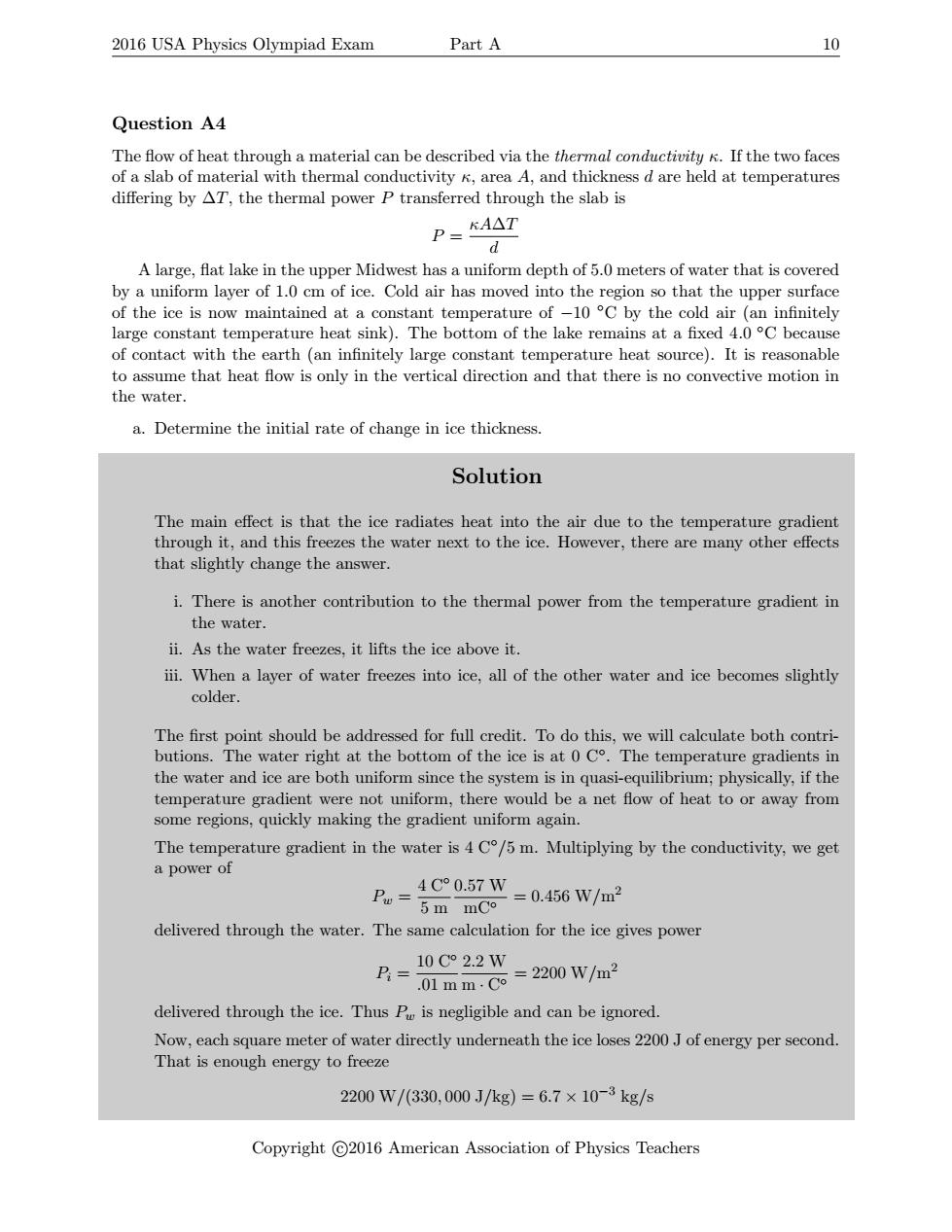正在加载图片...

2016 USA Physics Olympiad Exam Part A 10 Question A4 The flow of heat through a material can be described via the thermal conductivity k.If the two faces of a slab of material with thermal conductivity K,area A,and thickness d are held at temperatures differing by AT,the thermal power P transferred through the slab is P=AAT d A large,flat lake in the upper Midwest has a uniform depth of 5.0 meters of water that is covered by a uniform layer of 1.0 cm of ice.Cold air has moved into the region so that the upper surface of the ice is now maintained at a constant temperature of-10 C by the cold air (an infinitely large constant temperature heat sink).The bottom of the lake remains at a fixed 4.0C because of contact with the earth (an infinitely large constant temperature heat source).It is reasonable to assume that heat flow is only in the vertical direction and that there is no convective motion in the water a.Determine the initial rate of change in ice thickness. Solution The main effect is that the ice radiates heat into the air due to the temperature gradient through it,and this freezes the water next to the ice.However,there are many other effects that slightly change the answer. i.There is another contribution to the thermal power from the temperature gradient in the water. ii.As the water freezes,it lifts the ice above it. iii.When a layer of water freezes into ice,all of the other water and ice becomes slightly colder. The first point should be addressed for full credit.To do this,we will calculate both contri- butions.The water right at the bottom of the ice is at 0 Co.The temperature gradients in the water and ice are both uniform since the system is in quasi-equilibrium;physically,if the temperature gradient were not uniform,there would be a net flow of heat to or away from some regions,quickly making the gradient uniform again. The temperature gradient in the water is 4 Co/5 m.Multiplying by the conductivity,we get a power of P。=4C0.57W=0.456w/m2 5m mCo delivered through the water.The same calculation for the ice gives power B=10C22W =2200W/m2 .01 mm.Co delivered through the ice.Thus P is negligible and can be ignored. Now,each square meter of water directly underneath the ice loses 2200J of energy per second. That is enough energy to freeze 2200W/(330,000J/kg)=6.7×10-3kg/s Copyright C2016 American Association of Physics Teachers2016 USA Physics Olympiad Exam Part A 10 Question A4 The flow of heat through a material can be described via the thermal conductivity κ. If the two faces of a slab of material with thermal conductivity κ, area A, and thickness d are held at temperatures differing by ∆T, the thermal power P transferred through the slab is P = κA∆T d A large, flat lake in the upper Midwest has a uniform depth of 5.0 meters of water that is covered by a uniform layer of 1.0 cm of ice. Cold air has moved into the region so that the upper surface of the ice is now maintained at a constant temperature of −10 ◦C by the cold air (an infinitely large constant temperature heat sink). The bottom of the lake remains at a fixed 4.0 ◦C because of contact with the earth (an infinitely large constant temperature heat source). It is reasonable to assume that heat flow is only in the vertical direction and that there is no convective motion in the water. a. Determine the initial rate of change in ice thickness. Solution The main effect is that the ice radiates heat into the air due to the temperature gradient through it, and this freezes the water next to the ice. However, there are many other effects that slightly change the answer. i. There is another contribution to the thermal power from the temperature gradient in the water. ii. As the water freezes, it lifts the ice above it. iii. When a layer of water freezes into ice, all of the other water and ice becomes slightly colder. The first point should be addressed for full credit. To do this, we will calculate both contributions. The water right at the bottom of the ice is at 0 C◦ . The temperature gradients in the water and ice are both uniform since the system is in quasi-equilibrium; physically, if the temperature gradient were not uniform, there would be a net flow of heat to or away from some regions, quickly making the gradient uniform again. The temperature gradient in the water is 4 C◦/5 m. Multiplying by the conductivity, we get a power of Pw = 4 C◦ 5 m 0.57 W mC◦ = 0.456 W/m2 delivered through the water. The same calculation for the ice gives power Pi = 10 C◦ .01 m 2.2 W m · C◦ = 2200 W/m2 delivered through the ice. Thus Pw is negligible and can be ignored. Now, each square meter of water directly underneath the ice loses 2200 J of energy per second. That is enough energy to freeze 2200 W/(330, 000 J/kg) = 6.7 × 10−3 kg/s Copyright c 2016 American Association of Physics Teachers